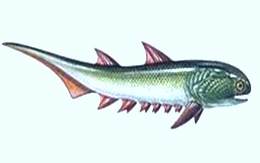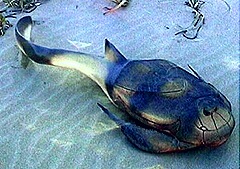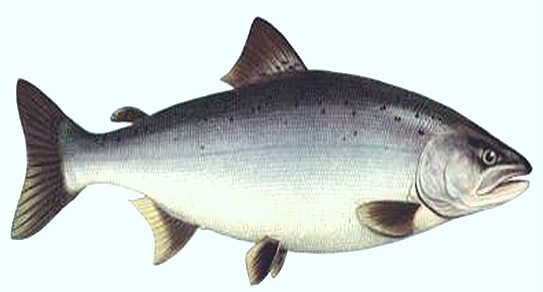PISCES –(FISHES) CLASSIFICATON:
PISCES-CLASSIFICATION
The super class Gnathostomata includes craniates, in which one pair of the visceral arches is modified into this jaws. They how internal ear with three semi-circular canals and provided with paired 4, apdages (fins or limbs). Sexes are separate. The super class is divided into, two groups.
1) Pisces and 2) Tetrapoda.
Pisces Include three classes.
.1) Placodemi,
.2) Elasmobronchi (Chondrichthyes),
3) Osteichthyes.
Muller, Goodrich. Berg, Romer etc, classified the Pisces. There is no agreement among many authors with respect to the classification of fishes.
Class 1 Placodermi (Aphstohyoids)
1) It includes extinct fishes.
2) They are all armored fishes. Their exoskeleton Is in the form of bony plates or shields.
3) Their endoskeleton is bony:
4) The hyoidean gill-slits are complete. It is not reduced.
5) The autodiastylic jaw suspension is seen in these fishes.
6) Heterocercal caudal fin is seen.
7) Hyoid arch will not support the jaws.
8) Primitive jaws are seen.
9) They survived up to Permian period of Paleozoic era.
Ex Climatius, Bothriolepis.


Class 2. Chondrlchthys or Elasmobranchi
1) These fishes are exclusively marine.
2) The exoskeleton in the form of placoid scales.
3) Their endoskeleton is cartilagenous and are called Cartilage
4) Jaw suspension is amphistylic or hyostylic.
5) 5-7 pairs of gills are present.
6) External gill openings are separate. They are not covered by operculum.
7) Heterocercal caudalfin is seen.
8) Males show claspers for copulation.
9) Air-bladder is absent in these fishes.
The Class Elasmobranchi is divided into two sub-classes.
1. Sub-class Selachi :-
In these fishes the pectoral fin has cartilagenous rods. Fins are well developed. The caudal fin is hetetocercal. This subclass has four orders in which only two are living.
Order 1. Proto selachl
1) Jaws show many pointed teeth.
2) Nasal openings are paired.
3) Hyostylic or Axnphistylic jaw suspension.
It is represented by few living species.
Ex :Heteroloatas
Order 2. Euselachi
1) Skin contains placoid scales.
2) These fishes are exclusively marine.
3) 5 pairs of gill slits. They open separately. It is divided into two
1. Sub-order . Pleurotremata:
1) Gill slits on the lateral sides of the body.
2) Pectoral fins are distinct.
3) It includes sharks and dog fishes.
Ex :- Scoliodon, Sphyrna (Hammer headed shark), Stegostoma (Tiger shark).
2. Sub-order Hypotermata:
1) It includes skates And Rays.
2) The body is flattened dorso-ventrally.
3) Pectoral fins are enormously expanded anterio posteriorly and gill openings are ventral and five in number.
4) Dorsal fins, if present are seen on the tail.
Lx :- Pristis (Saw fish), Rhinobatus (Guitar fish), Torpedo (Electric ray), Raja (Skates), Trygon (sling rays), Myliobatis (Eagle rays)
Sub-Class 2; Bradyodonti
It includes fossil and modern chimaeras.
1. Mouth is small and bounded by lips.
2. Holostylic jaw suspension is seen.
3. Gill opening are enclosed in boneless operculum.
4. Male possesses a frontal clasper on the head.
It is divided into 2 orders.
Order 1. Eubradyodonti
‘It includes Helodus’.
order2. Holocephali
It includes chimaera. These are called devil fishes. Chimaera
also called king of Hernngs. Chimara
Class 3. Osteichthyses a Telostomi
1. These fishes are marine, fresh water and bracldsh water niem hers.
2. Cycloid, ctenoid or ganoid scales will form the exoskeleton.
3. Endoskeleton bony.
4. Jaws suspension is autostylic
5. Operculum is present.
6. Claspers are absent
7. Usually air bladder is present
This class is divided Into two sub-classes.
Sub-Class I. Crossopterygii,
Sub-Class 11. Actinopterygii,
Sub-Class-I: Crossoptenygii
In this sub-class bony fishes are Included which show lobed and massive fins. The sub-class includes two orders,
Order - 1 Rhipidistia
This order includes extinct fishes. But in 1938 one coelacanth fish was caught. This was identified as, Rhipidistian fish by Miss. Latimer. The fish is called Latimeria. It is the oldest living fossil.
coelocanth
Ortler -2. Dipnoi
This order Includes living fishes. In the present day only 3 genera are living. They show discontinuous distribution.
Ex: 1. Neoceratodus (Australian lung fish),
2). Protopterus (African lung fish),
3. Lepldosiren (South American lung fish).
Sub-class II Actinopterigii
These fishes will live in fresh water or marine water. They not show internal nostrils. This subclass is divided into three super orders.
Super order I: Chondrostei
This super order includes 3 orders, only fishes of one order or surving
Order polypterifonnes :- The fishes wtth ganoid scales Caudal fin is symmetrical. Dorsal fin has many peculiar fin-lets.
Ex:Polypterus.
Super order II: Holostel:
This include 2 orders.
Order 1. Amiiformes.
Caudal fin is heterocercal. Ex Antia (Bowin).
Order 2. Lepldoeteiformes:
Nasal opening at the end of the much elongate snout. Caudal fin is abbreviate heterocercal.
Ex: Lepidpsteus (Gar pike).
Super order III. Telosteti : This is a very important super order. It includes nearly 25,000 species. They are divided into many orders.
Order I. Clupelfonnee : Caudal fin is homocercàl.

Ex: 1. Hilsa hisha (Herrings).2. Salmon.
Order 2. Cypriniformes: Weberian ossicles connecting the ear with air bladder is present. Mr-bladder is connected with duct to the alimentary canaL
Ex : - Carps. (Labeo, Cinhina, Barbus).
Order 3. Anguilllformes. : Body eel like, air-bladder, If present connected with intestine by a duct.
Ex:Anguilla.
Order 4. Beloniformes :Physoclistic fishes in which fins are without spines.
Ex : Exocoetus, (flying fish)., Cypsilurus
Order-5. Syngnathlformes: Physoclistic fishes In which the first dorsal fin, If present, Is spinous.
Ex Hippocampus (Sea horse). Syngnathus (Pipe-fish)
Order 6: Syinbranehiformes: Eel like body, air-bladder is absent spines absent In fins.
Ex Asnphinuous.
Order 7. Psrciformes: Physoclistic fishes fins usually with spines. Usually two dorsal fins.
Eg: Fierasfer, Anabas (Climbing perch).
Order 8. Pleuronectiformes. Both eyes are situated on one side skull is asymmetilcal. Fins usually without spine. Adults without air bladder.
Ex :Cynogiossus
Order 9. Echenelformes The spinous dorsal fin is t into an adhesive disc placed on the head. Air bladder is absent.
Ex: Echenis (Sucker fish).
Order 10. Ophiocephaliformes: Physoclisfic fishes in which are Without spine, scales are cycloid, air bladder is very long.
Ex Channa or opiocephalus.
Order 11. Tefradontiformes : Gill openings restricted air bladder is present or absent.
Ex: Tetrodon, Diodon (Porcupine fish).
Order 12. Gadiformes Physoclistic fishes in which fins are without spines, scales cycloid.
